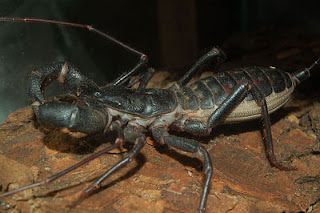Having looked at the lizardfolk a few months ago, I'm going to (more briefly, I suspect) look at the other low-level race of reptilian humanoids in D&D: the troglodytes. Like lizardfolk, troglodytes have no real counterpart in mythology or legend.
Having said which, the term, which literally means "cave-divers" in Ancient Greek, is an old one, and was used to refer to a purported human tribe by Herodotus back in the 5th century BC, and by other authors since. It's often used to refer to cave-dwelling subterranean races, such as H.G. Wells' Morlocks, and even has its place in modern taxonomy as a part of the scientific names of a number of creatures (most notably chimpanzees and wrens). But none of these things have any real connection to the race described by Gygax, for which, so far as one can tell, he simply borrowed the name.
1E
Troglodytes, as described in the original Monster Manual, are a reptilian humanoid race distinguished from lizardfolk by a number of features. Their feet are more digitigrade (that is, they stand on their toes, but not on their heel), their tail and snout shorter, and their head more rounded. They are also slightly shorter, but more heavily built, and have a large crest on their head supported by a row of spines - while lizardfolk now have a head-crest as well, this did not appear until 3E, making it perhaps the most obvious physical difference at the time.
They live only in subterranean caverns, as one would expect given their name, and hate all human life. (From context, this probably means mammalian humanoids in general, rather than humans specifically). They have a similar intelligence to the more bestial lizardfolk, and don't wear any form of clothing or armour, with only a few belts to carry their primitive stone tools and weapons. Despite being chaotic, they live in communities averaging a hundred or so individuals, with chieftains and other leaders, but perhaps little in the way of formal organisation or customs.











.jpg)
